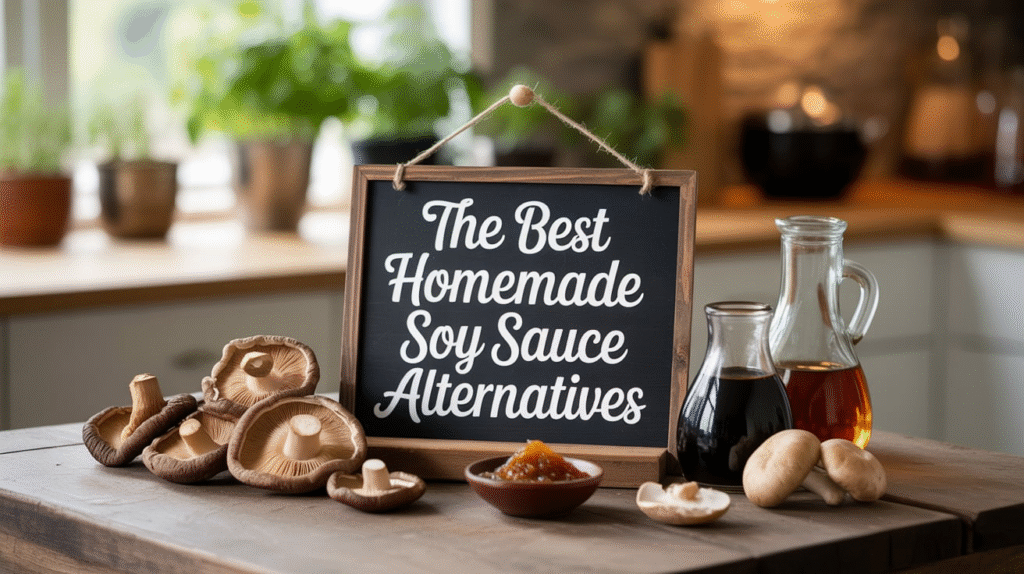Affiliate Disclosure: PantryBrands.co.uk is a participant in the Amazon.co.uk Associates Programme. As an Amazon Associate, we earn from qualifying purchases made through links on this site.
If you’ve run out of soy sauce or need a gluten-free, low-sodium, or soy-free option, there are several effective homemade soy sauce alternatives using ingredients already in your kitchen. These substitutes won’t taste exactly the same but can replicate the salty, umami-rich profile soy sauce adds to dishes.

In this guide, we’ll explore homemade soy sauce substitutes that work for stir-fries, marinades, dipping sauces, and more – all tailored to different dietary needs and preferences.
Why People Look for Soy Sauce Alternatives
There are several reasons people seek alternatives to soy sauce, from dietary restrictions to health concerns or simple unavailability at home.
Common Reasons Include
People often need to swap out soy sauce for reasons such as:
- Gluten intolerance or coeliac disease (many soy sauces contain wheat).
- Soy allergies or soy-free diets.
- Reducing sodium for heart or kidney health.
- Preference for natural, additive-free ingredients.
Homemade alternatives allow for full control over flavour, sodium, and allergens.
Quick Soy Sauce Substitutes Using Pantry Ingredients
When you’re in a hurry, you can whip up a substitute using everyday items.
Balsamic Vinegar + Worcestershire Sauce
This combo gives depth, saltiness, and acidity.
- Mix 2 tablespoons of balsamic vinegar with 1 tablespoon of Worcestershire sauce.
- Add a dash of water or beef/vegetable stock to balance strength.
Miso Paste + Water + Salt
Miso delivers umami similar to soy sauce.
- Blend 1 tablespoon of miso paste with 2–3 tablespoons of warm water.
- Add a small pinch of salt or tamari for extra punch if gluten-free soy is allowed.
Low-Sodium Homemade Soy Sauce Alternative
For those watching sodium intake, this mix delivers flavour without overwhelming salt.
Molasses + Apple Cider Vinegar + Garlic Powder
Molasses offers depth and colour while vinegar adds acidity.
- 1 tablespoon blackstrap molasses
- 2 tablespoons apple cider vinegar
- ½ cup low-sodium beef or vegetable broth
- ¼ teaspoon garlic powder
- Simmer for 5–10 minutes until slightly reduced.
This creates a dark, savoury, and slightly sweet liquid resembling soy sauce in both colour and umami feel.
Gluten-Free Soy Sauce Substitute Recipe
If gluten is the issue, a tamari-based or miso-based homemade alternative is your best choice.
Tamari + Rice Vinegar + Sesame Oil
This combo brings a complex yet gluten-free flavour base.
- 2 tablespoons tamari (naturally gluten-free)
- 1 tablespoon rice vinegar
- A few drops of toasted sesame oil
- Optional: pinch of garlic or ginger powder
Tamari is essentially soy sauce without wheat, and this mix enhances it with nutty and tangy tones.
Soy-Free Soy Sauce Alternative
For those avoiding soy entirely, coconut aminos are a popular base for a DIY substitute.
Coconut Aminos + Mushroom Broth + Vinegar
Coconut aminos are lower in sodium and soy-free.
- 3 tablespoons coconut aminos
- 2 tablespoons mushroom broth or stock
- 1 teaspoon balsamic vinegar or apple cider vinegar
This blend mimics the earthy, salty taste of soy sauce and works well for dipping and marinades.
Shelf-Stable Alternative for Bulk Use
If you want a homemade alternative that stores well, this savoury brew works for batch preparation.
Homemade “Umami Sauce” Base
Boil the following mixture and cool before storing:
- ½ cup vegetable broth
- 1 tablespoon molasses
- 1 tablespoon vinegar (rice or apple cider)
- 1 teaspoon garlic powder
- ½ teaspoon ground ginger
- Optional: a splash of sesame oil
Store in the fridge in a clean bottle for up to 2 weeks.
When to Use Homemade Alternatives (And When Not To)
Homemade soy sauce substitutes work in many situations, but not all. Use alternatives wisely for best results.
Best Uses for Homemade Alternatives
They perform well in dishes where soy sauce is blended or cooked into other ingredients.
- Stir-fries
- Rice dishes
- Marinades
- Stews and soups
When Soy Sauce Is Irreplaceable
Some uses require the specific sharpness and salt profile of traditional soy sauce.
- Dipping sushi or sashimi
- Classic teriyaki or yakitori
- Preserved dishes needing salt as a curing agent
Tips for Making the Most of Substitutes
Homemade substitutes can taste fantastic with the right tweaks.
Best Practice Tips
- Adjust salt levels to taste, especially when using broth or miso.
- Store in a clean jar or bottle in the fridge.
- Taste-test in small portions before adding to the full dish.
- Add a few drops of sesame oil or fish sauce to increase authenticity.
FAQs About Homemade Soy Sauce Alternatives
Here are some questions and answers about making or using soy sauce substitutes.
Can I make soy sauce at home without soy?
Yes, you can make soy-free alternatives using coconut aminos, broth, vinegar, and molasses. While they won’t taste identical to soy sauce, they replicate the umami and salty elements effectively.
Is homemade soy sauce healthier?
Homemade substitutes can be healthier, especially if you reduce sodium and avoid additives. You have full control over the ingredients, making it suitable for special diets.
What’s the best soy sauce alternative for gluten-free diets?
Tamari is the most direct substitute, but miso and coconut aminos are also excellent gluten-free options. Always check the label to ensure no hidden wheat or barley.
How long do homemade soy sauce substitutes last?
Most homemade blends last around one to two weeks in the fridge. Always use a sterilised container and label the date of preparation.
Can I use Worcestershire sauce instead of soy sauce?
Worcestershire sauce can mimic the savoury punch of soy sauce in some recipes, but it’s more tangy and less salty. It works best when paired with balsamic vinegar or broth in a substitute blend.
